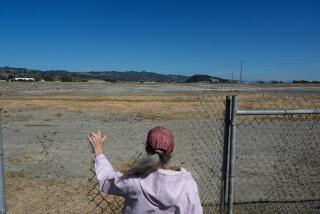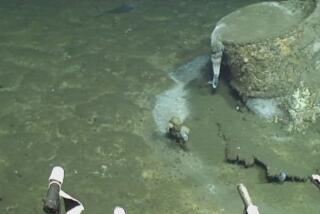Nuclear Waste Isotope Shows Promise in Cancer War
- Share via
OAK RIDGE, Tenn. — Locked away for more than 40 years in guarded concrete vaults at the Oak Ridge National Laboratory may be the key to a promising new therapy for cancer patients.
The lab’s 1 1/2-ton cache of weapons-grade uranium-233, until now considered waste, is the nation’s only readily available source for a potent isotope that can kill leukemia cells without harming healthy cells.
“It is kind of like a little bomb going off that you can target right to that cancer cell,” said the lab’s program manager, Jim Rushton.
Researchers at Memorial Sloan-Kettering Cancer Center in New York are developing the “alpha particle immunotherapy” and last year completed initial human tests.
The isotope bismuth-213 was attached to an antibody designed to carry the alpha-emitting isotope to the cancer. The tests were to see if the treatment did more harm than good in acute myeloid leukemia patients.
The results were a surprise. Not only was the therapy safe, but leukemia cells were eliminated in the bloodstream and reduced in the bone marrow of 13 of the 18 patients taking part, said Dr. Joseph Jurcic, one of the researchers.
“We really think it has broad implications for the whole field of oncology, not just for leukemia,” he said.
The researchers don’t envision bismuth therapy replacing chemotherapy or surgery. Rather they see its potential in “cleaning up residual cancer cells that are remaining behind after primary treatments,” he said.
This is no small challenge. Jurcic said only 30% to 40% of acute leukemia patients are cured by chemotherapy.
“The majority of these patients go into remission with chemotherapy, but they relapse because of these residual cells. That’s where we think the bismuth is going to be particularly useful.”
This fall, Sloan-Kettering, under the watch of the National Cancer Institute, plans to start a second phase of testing with 35 to 40 patients to measure the therapy’s effectiveness. The trials could last three years.
“The advantage of alpha-emitters is that they deposit a large amount of energy in a very small area of tissue,” said Dr. Jorge Carrasquillo, deputy chief of nuclear medicine at the National Institutes of Health.
Attaching the bismuth to antibodies that can carry the radiation dose straight to diseased cells is an “innovative treatment,” and Sloan-Kettering is leading the way, he said.
“Of course it is too early to tell the final role,” Carrasquillo said, “but it certainly is a strategy worth pursuing.”
The problem was getting more bismuth-213, an exotic isotope with a 46-minute half-life--making it difficult to acquire but perfect for injecting into patients.
Bismuth-213 can be obtained in what physicists describe as a decay chain from uranium-233. First, thorium-229 is extracted, then actinium-225 is taken from that and then the bismuth is extracted from the actinium.
The search for thorium led to the uranium-233 stockpile in Oak Ridge.
Energy Secretary Bill Richardson agreed in June, at the behest of Sen. Fred Thompson (R-Tenn.) and Rep. Joe Knollenberg (R-Mich.), to double the supply of bismuth-213 by 2002 for the Sloan-Kettering research.
Rushton said only 1% of the available bismuth-213 has been recovered from Oak Ridge. The total of bismuth-213 there is infinitesimally small--so small that it is measured by its radioactivity instead of its weight.
A typical shipment to Sloan-Kettering “is literally a spot of material that is dried in the bottom of a vial. It looks like the vial is empty,” Rushton said.
But researchers believe there is enough high-powered bismuth-213 at Oak Ridge to treat up to 100,000 cancer patients a year.
Oak Ridge’s uranium-233 was made at the government’s weapons fuel production plants in South Carolina and Washington state in the 1950s and 1960s. It was never intended for bombs, but for commercial nuclear plants.
At the time, uranium sources were scarce and nuclear power generation looked promising.
“But nuclear power did not grow as rapidly as the too-cheap-to-meter advocates had said, and people found all kinds of uranium out there,” Rushton said. “The price fell, and the economic need for this as an alternative fuel never developed.”
And so the uranium-233, considered more hazardous than enriched uranium for weapons--which also is stored in Oak Ridge--has remained at the Oak Ridge lab complex. It costs $15 million a year to store, and some experts estimate it will cost even more to dispose of.
Although the bismuth extraction will not reduce the volume of uranium-233, it at least gives value to the uranium’s manufacture, Rushton said.
“We spent a lot of money making this stuff,” he said. “If we had disposed of all this 10 years ago, we wouldn’t have the option to look at bismuth-213 today.”
*
On the Net:
Memorial Sloan-Kettering Cancer Center: https://www.mskcc.org/patients_n_public/clinical_trials/index.html
Oak Ridge National Laboratory: https://www.ornl.gov






